Reflectivity
Definition: the ratio of reflected optical power to the incident optical power at a surface
German: Reflektivität, Reflexionsgrad
Formula symbol: <$R$>
Author: Dr. Rüdiger Paschotta
Cite the article using its DOI: https://doi.org/10.61835/l0j
Get citation code: Endnote (RIS) BibTex plain textHTML
The reflectivity of a surface (e.g. an interface between two optical media) is defined as the ratio of reflected optical power to the incident optical power. Usually, it is applied to cases with specular reflections on exactly flat unstructured surfaces, i.e., not to extended objects and diffuse reflections.
Strictly speaking, according to the rules of radiometry, the term reflectivity should be used only for reflections occurring at one particular pure surface – not for example for reflections at extended objects, such as glass plates or optical resonators, or on rough surfaces; in such cases, the term reflectance is appropriate. However, it is common, for example, to specify reflectivities of laser mirrors or anti-reflection coatings, although these are usually based on dielectric coatings, involving interferences between reflections from many different optical interfaces. One then actually considers a whole thin-film structure, usually having an overall thickness far below 1 mm, as one surface. A more questionable case is a fiber Bragg grating, which can be far more extended.
Relation to Reflection Coefficients
The reflection at an optical surface is also often described with a complex reflection coefficient. Its squared modulus is the reflectivity, and it also carries a complex phase according to the optical phase change upon reflection.
Fresnel Equations
Complex reflection coefficients and reflectivities at optical interfaces can be calculated with Fresnel equations. They depend only on the refractive indexes of both optical materials.
More to Learn
Encyclopedia articles:
Questions and Comments from Users
Here you can submit questions and comments. As far as they get accepted by the author, they will appear above this paragraph together with the author’s answer. The author will decide on acceptance based on certain criteria. Essentially, the issue must be of sufficiently broad interest.
Please do not enter personal data here; we would otherwise delete it soon. (See also our privacy declaration.) If you wish to receive personal feedback or consultancy from the author, please contact him, e.g. via e-mail.
By submitting the information, you give your consent to the potential publication of your inputs on our website according to our rules. (If you later retract your consent, we will delete those inputs.) As your inputs are first reviewed by the author, they may be published with some delay.

 general optics
general optics
Connect and share this with your network:
Follow our specific LinkedIn pages for more insights and updates: